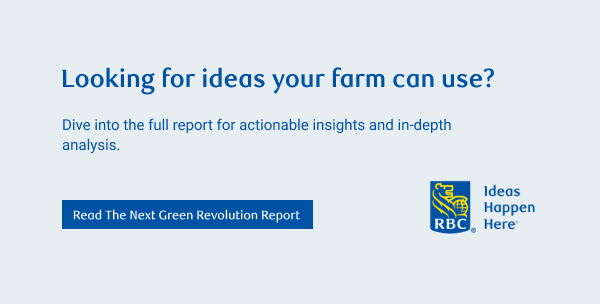| |

|
| |
|
How we grow, process, and consume food isn't just part of the climate crisis; it can be a crucial solution. And Canadian producers are uniquely positioned to lead this charge, offering a made-in-Canada, farmed-in-Canada solution for the world.
|
| |
|
Leading a low carbon farming revolution
|
| |
|
Canada's agricultural sector faces a pivotal moment with rising global food demand, climate change disruptions, and geopolitical instability. Despite challenges, Canada is positioned to lead in addressing these issues, leveraging its productive farms, ample land, stable regulations, and reputation for quality food supply. However, agricultural success has contributed to emissions, necessitating a shift toward sustainable practices to mitigate climate impact.
|
| |
|
Four key building blocks for a low emissions agriculture and food system
|
| |
- Fertilizer: Did you know that fertilizer production and use contribute to 30% of our total agricultural emissions? By addressing this, producers can significantly reduce their carbon footprint.
- Regenerative agriculture: Practices aimed at improving soil health and biodiversity can not only benefit the environment but also help sequester greenhouse gases.
- Livestock: With innovations in feed additives and selective breeding, producers can lower emissions from cattle digestion, which currently accounts for a substantial portion of agricultural emissions.
- Embracing the agriculture technology revolution: Investing in sustainable agriculture technology and innovation is crucial for driving emissions reduction in the agricultural sector.
|
| |
|
Key findings from the report
|
| |
- Canada’s agriculture and food systems produce 93 megatonnes or just over 10% of our national greenhouse gas emissions annually.
- By 2050, these emissions could rise to 137 megatonnes.
- Key technologies and approaches, such as carbon capture and precision technology, can help cut emissions by up to 40% by 2050.
- A national effort, tailored to regional contexts and focused on the key pillars of technology, finance, skills and public policy, will be essential to increasing our production while also cutting emissions.
|
| |
|
|
|
| |

|
| |
*This article is intended as general information only and is not to be relied upon as constituting legal, financial or other professional advice. A professional advisor should be consulted regarding your specific situation. Information presented is believed to be factual and up-to-date but we do not guarantee its accuracy and it should not be regarded as a complete analysis of the subjects discussed. All expressions of opinion reflect the judgment of the authors as of the date of publication and are subject to change. No endorsement of any third parties or their advice, opinions, information, products or services is expressly given or implied by Royal Bank of Canada or any of its affiliates.
®/™Trademark(s) of Royal Bank of Canada. RBC and Royal Bank are registered trademarks of Royal Bank of Canada.
RBC Royal Bank | Royal Bank of Canada l RBC Waterpark Place, 88 Queens Quay West, 12th Floor, Toronto, ON, M5J 0B8, Canada | www.rbcroyalbank.com
|
|
| |
|
|